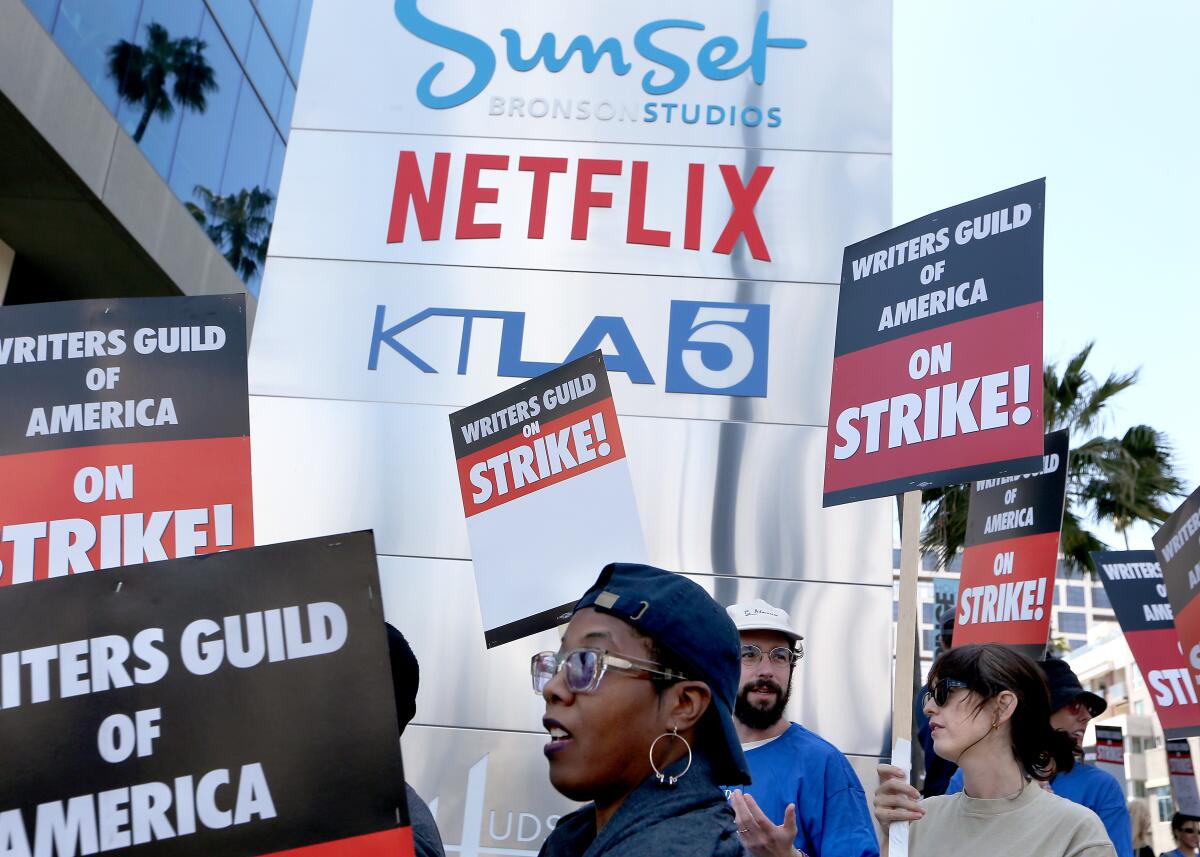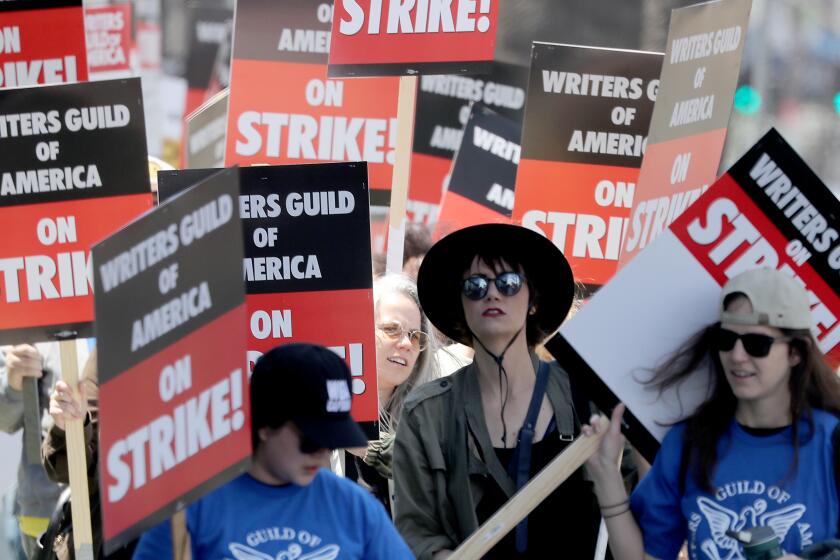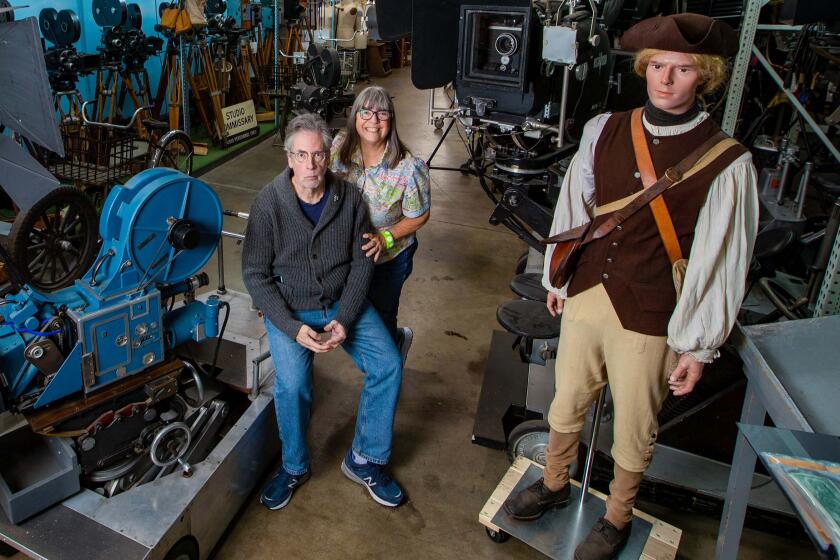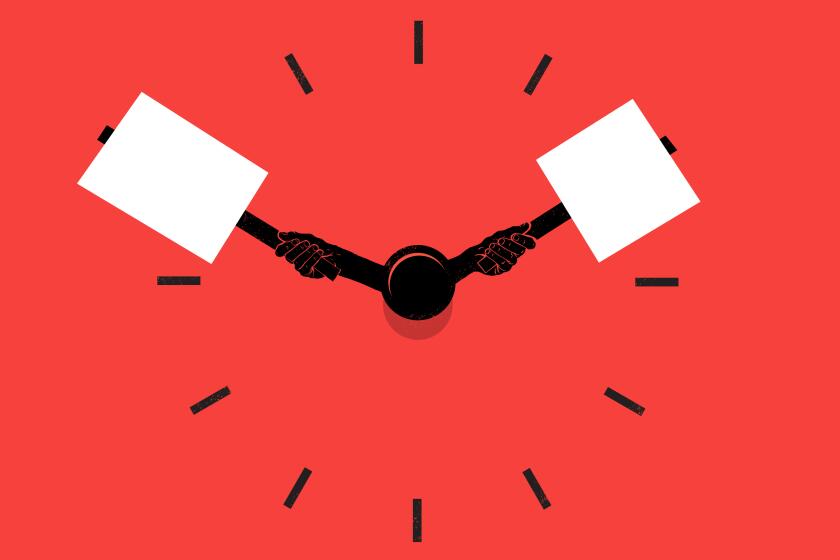Hollywood is calling it ‘the Netflix strike.’ Here’s why

- Share via
Netflix is one of the entertainment industry’s power centers — and its change agent.
So much so that the streaming giant also has become an avatar of anxiety for Hollywood writers who are entering the second week of a historic strike that has no end in sight.
Some in the 11,500-member Writers Guild of America have focused their frustration on the streaming company. In the industry, some are dubbing this year’s labor action “the Netflix strike.”
“Netflix in a lot of ways has upended the business model, and broken it in fundamental ways,” Jaclyn Moore, an executive producer and writer for “Queer as Folk” on Peacock and “Dear White People” on Netflix, said Monday from the picket line near Netflix’s sleek Sunset Boulevard offices.
The 2023 writers’ strike is over after the Writers Guild of America and the Alliance of Motion Picture and Television Producers reached a deal.
Moore was joined by hundreds of WGA writers who demonstrated outside Netflix’s offices to protest for better pay and working conditions. They cited tensions and changes to the business, which they say have been exacerbated by the streaming revolution that Netflix kicked off.
Those changes, writers argue, have made it harder to support a family in Los Angeles while writing on shows for guild minimums. The boisterous crowd included pregnant women, parents with children carrying signs saying “daycare is expensive,” and the guild’s WGA chief negotiator, Ellen Stutzman, who pushed her child in a stroller along the picket line.
“Streaming is the problem,” said writer Janet Lin, who worked on the first season of Netflix’s hit “Bridgerton,” one of television’s most beloved shows during the pandemic.
Netflix helped change the way people watch TV shows and movies by giving consumers what they wanted — on-demand viewing instead of having to wait for the latest episode, and with an option that was cheaper than the pay-TV bundle.
The company did so while delivering hits such as “Squid Game,” “Bridgerton,” and “Tiger King,” spending about $17 billion a year on programming and becoming one of Hollywood’s most important employers.
The downside for many writers was that it changed the way they were compensated and how shows were made, in ways that they argue now threaten their livelihoods.
“They changed the model, for a lot of good,” said Stephanie Hicks, a WGA member since 2016 who has worked on ABC’s “Castle” and “The Rookie: Feds.” “There’s so much more content available worldwide. But you have to pay the content creators.”
As productions shut down due to the writers’ strike, local prop houses, florists and caterers worry about their future and loss of work, as their business costs continue to rise.
Netflix co-Chief Executive Ted Sarandos said in a recent earnings presentation that the company’s deep library of shows and movies will help it withstand a strike in the near term. However, production of several Netflix shows has been disrupted, among them “Stranger Things,” according to its creators, the Duffer brothers. “Cobra Kai” and “Unstable” also were shut down.
“We respect the writers and we respect the WGA, and we couldn’t be here without them,” Sarandos said during the call last month. “We don’t want a strike.”
The Los Gatos, Calif., company adopted shorter TV seasons with fewer episodes, assembled smaller writers rooms for shorter periods of time and paid artists upfront rather than with a staggered “back end,” which would be lucrative when a show played in syndication or when a movie hit cable TV.
Many of those practices have been embraced by the legacy media companies including Walt Disney Co., Amazon Studios and WarnerMedia (now Warner Bros. Discovery), which launched streaming services to compete with Netflix.
“They’ve been responsible for a lot of innovations and disruptive practices that, for the most part, have been embraced by the creative community, but the business part is now catching up,” said Tom Nunan, a former studio and TV network executive.
Netflix didn’t invent many of these changes roiling the industry.
Inside the business of entertainment
The Wide Shot brings you news, analysis and insights on everything from streaming wars to production — and what it all means for the future.
You may occasionally receive promotional content from the Los Angeles Times.
Several of the trends — including the use of television seasons with fewer than 22 episodes — were underway before its streaming service electrified the business. HBO’s “The Sopranos” and “Sex and the City” and FX’s “Nip/Tuck” all had shorter seasons.
Even though Netflix didn’t necessarily cause all the writers’ problems, the company helped make certain practices commonplace, said Evan Shapiro, a former NBCUniversal executive who now runs his own company.
“They are that brass ring that everyone chased, only to find that it was made out of tin,” Shapiro said. “They’re not alone in it, but they definitely started it.”
The Alliance of Motion Picture and Television Producers, the organization that represents the media companies, said the rise of subscription video-on-demand has created more opportunities for writers to work on a TV series because so many more shows are getting made.
Writers also get paid residuals after the first season, while the syndication model hinged on a show running at least four seasons. During the last contract, the studios agreed to boost the residual rates, which has led to more residuals being paid. The value of residuals has increased 28.1% from 2016 to 2021, rising from $385.4 million to $493.6 million, according to WGA data.
In the days before the Writers Guild of America called on members to strike, the creators of hit shows, including ‘Shrinking,’ ‘The Last of Us’ and more, gathered to discuss the state of the industry.
One of the ways that Netflix disrupted Hollywood was by making it a common practice for the streamer to greenlight a series based on a script rather than on a pilot episode. Although Netflix wasn’t the first — AMC Networks has based its pick-up decisions on scripts, not pilots, since about 2015 — it accelerated the trend.
“That’s a very appealing proposition for most show writers, because they’re not having to go for the audition process of a pilot,” Nunan said. “That made Netflix stand out and it really disrupted the business. Many other companies followed suit after that.”
On the other hand, Netflix originals would live exclusively on its platform, cutting out the traditional syndication market that delivered hefty paydays for creatives on successful shows.
“There’s a price to pay for that,” Nunan said. “There’s a residual price to pay. And that’s what the strike is largely about.”
A new deal structure could have a significant impact on the long-term earnings of show creators.
One of the most contentious developments among writers is a new mode of work popularized by streamers. Streaming services hired small groups of writers to flesh out a series before going into production. Those small groups, called mini-rooms, have been criticized by the WGA for eroding writer pay. Some writers spend weeks, if not months, writing three to six episodes of a show that doesn’t get picked up.
While working on the traditional 22-episode broadcast series, writers could be employed for nearly 10 months a year. Now, the new “typical” employment for lower- and midlevel writers on a streaming series is 20 to 24 weeks, or only 14 weeks if the room is convened without a series order, the WGA said in a recent report.
Most of Netflix’s writers’ rooms last for 20 weeks, according to a Netflix spokesperson.
Another issue for writers is how having hands-on experience working on a show throughout the creative process — often from the pilot pickup to filming individual episodes — has gone away.
Geetika Lizardi, who worked as a writer on her first show, NBC’s “Outsourced,” in 2010, was employed about nine months of the year, working through production and postproduction and learning about the editing process. But on streaming shows, jobs span about 20 weeks.
“You can’t sustain a living,” said Lizardi, who has been working on the yet-to-be-released Season 3 of Netflix’s “Bridgerton.” “It’s hard enough to get one job. And you need more like two or three to survive.”
Hollywood’s writers went on strike, but what were the issues that led to the fallout with the studios and streamers. Here are six issues where talks fell apart.
Studio executives acknowledge shortcomings to the current method because fewer writers are around during the production of a show. The problem is the industry is losing its time-honored pipeline to train showrunners.
Moore, the showrunner, also said streaming companies do not provide detailed viewership data, making it difficult for writers to know whether they are being paid adequately. The lack of data reduces negotiating power for creators when their show is a hit.
“What used to be public information, how was your show doing” is no longer available, Moore said. “The tech industry came in and made that information a black box.”
One of the proposals the WGA tried to introduce was making residuals payments based on viewership. But the AMPTP rejected the proposal.
Netflix pointed to how it shares data publicly on its most popular shows and movies and gives success metrics to showrunners and directors. Netflix’s top-10 page indicates the number of hours watched on its most popular programs, which is more data than other streamers such as Amazon’s Prime Video share.
Many in the industry want to see even more data disclosed.
“It’s really hard to negotiate the value of the product you create, if you don’t have the information about how successful or not successful that product is,” Moore said. “Instead, [you] just have to listen to a tech company to tell you to trust them.”
More to Read
Inside the business of entertainment
The Wide Shot brings you news, analysis and insights on everything from streaming wars to production — and what it all means for the future.
You may occasionally receive promotional content from the Los Angeles Times.

















